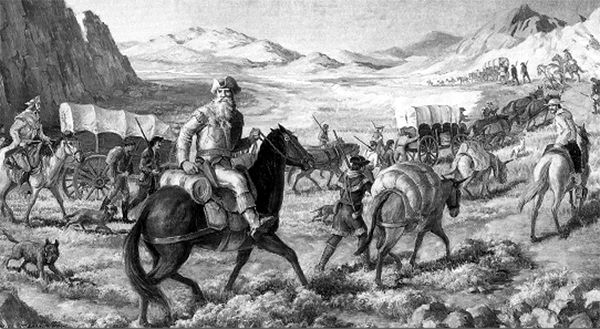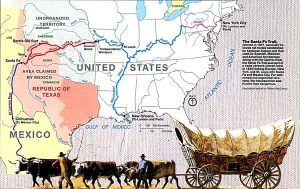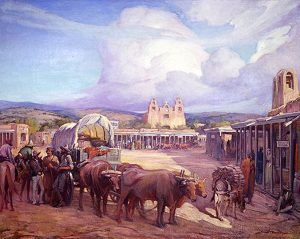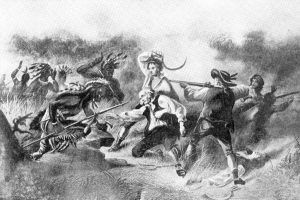what did william becknells trading route come to be known as

William Becknell blazes the Santa Fe Trail.
William Becknell was a frontiersman, trader, soldier, and political leader who is credited with opening the Santa Fe Trail in 1821
Becknell was born in Amherst County, Virginia, around 1788 to Micajah and Pheby Landrum Becknell. When he grew up, he married a woman named Jane Trusler in 1807 in Virginia. Three years later, the couple migrated to Missouri Territory, homesteading w of present-day St. Charles in 1810.
There, he became involved in the War of 1812 and joined Daniel Morgan Boone, the son of the famed explorer, and his visitor of United States Mounted Rangers as a sergeant in May 1813. He saw extensive service on the frontier during the war and was promoted to the rank of ensign in July 1814. He participated in Major Zachary Taylor'south campaign against British-backed Indians that culminated in the Boxing of Credit Island, at the site of present-day Davenport, Iowa, in September 1814. Afterward he was working nether the control of Captain James Callaway, Morgan Boone'south cousin and grandson of Daniel Boone. Calloway, an Indian fighter of some renown, was killed in a battle with Native Americans near Loutre Creek in March 1815. Afterward, Becknell assumed command of the company and Camp Clemson, Missouri. He was and so promoted to the rank of Captain and was long known as Captain Becknell.
Post-obit his discharge from Federal service in June 1815, Becknell returned to farming, trading horses, and freighting. Unfortunately, his wife had died at some point as he was married again to a Mary Chribbs, who bore him a daughter that aforementioned year. The couple would accept 4 more children over the years.
In 1816, he obtained a license to operate a ferry at the decorated Arrow Rock crossing of the Missouri River, and he equally his family moved to cardinal Missouri. In addition to operating the ferry, he was also engaged in freighting and in the table salt merchandise. Sometime in well-nigh 1817, he and his family moved a bit farther westward to Franklin, Missouri. In 1820, he was an unsuccessful candidate for the Missouri Business firm of Representatives.

Santa Fe Trail Map
The adjacent year, motivated by fiscal bug, he became the "Male parent of the Santa Fe Trail" when he organized a trading party that crossed the Great Plains to New United mexican states. He left Franklin, Missouri, with four companions in September 1821 on his kickoff trip to the western US with a load of freight to deliver to Santa Fe, New Mexico. He traveled via what would become known every bit the Mountain Branch of the Santa Fe Trail.
History has written for years that Becknell and his men, following the Arkansas River, spent two days moving rocks and then the horses could get through vii,834-foot-loftier Raton Pass, where Indians, conquistadors, trappers, and traders had already established a rough trail. However, that portion of the journey has been called into question subsequently the discovery of the diary of Pedro Ignacio Gallego in 1993. Mexican Captain Gallego and his 400 men met Becknell on his commencement journeying to Santa Iron, and his writings, along with Becknell's own journal describing the mural, show more evidence that he and his men probably misidentified the Canadian River and instead crossed another river or stream. Researchers at present say evidence points to a location between the Arkansas River and Puertocito Piedra Lumbre in Kearny Gap, south of nowadays-day Las Vegas, New Mexico.
Making it through safely, they continued on to Santa Fe, where the party was welcomed on November 16, 1821, and Becknell sold the goods at a high profit. After a month of trading, Becknell and his party left Santa Iron on December 13th. His investment of $300 in trading goods had returned approximately $6000 in money. The men returned to Missouri safely in Jan 1822.

The End of the Santa Fe Trail by Gerald Cassidy, virtually 1910
The profits made by William Becknell'southward first trading trip brought much-needed money and valuable goods into primal Missouri, where the Panic of 1819 had a devastating upshot on the economy. This economic low was caused, in large function, by a short supply of coin. With no cyberbanking system, paper money was considered worthless in Missouri, so simply gold and silver coins were accustomed as payment. No markets existed for farmers to sell their products or for merchants to peddle their wares, and many people were in debt. The influx of Mexican coins significantly helped Missouri'south economy as farmers, and local merchants found a new marketplace for their goods. The advent of legal trade with Mexico promised to counteract the effects of the economical panic in Missouri.
Very encouraged, he advertised for lxx men to "become west." Thirty men volunteered, and they left Missouri in May 1822 with some $iii,000-$5,000 in appurtenances. Taking wagons this fourth dimension, they explored a new road, leaving the Arkansas River near present-day Dodge Metropolis, Kansas, and crossing to the Cimarron River, thus blazing the Santa Fe Trail. Though both people and animals suffered considerable hardship, nearly dying of thirst in the parched Cimarron Desert, they arrived in Santa Fe 48 days later.
This was to be the commencement trip to open the road to regular traffic and military movement, which soon became the first and only international merchandise route betwixt the United States and Mexico until a railroad to Santa Fe was built in 1880. Becknell has since been known as the "Father of the Santa Fe Trail." This second trip was far more profitable than the showtime, with the political party returning to Missouri with a profit of around $91,000 dollars.
On his 3rd journey in 1824–25, he led a party of trappers into Colorado, and in 1825-1826, he participated in the federal grading and marking project of the Santa Fe Trail.

Blackhawk War
His start political appointment was as Justice of the Peace in Saline County, Missouri, in 1827. The side by side year, he was elected to the Missouri House of Representatives in 1828 and served two terms. Retaining his rank of Captain, Becknell served in the Missouri land militia during a Native American uprising in 1829 and again during the 1832 Black Hawk War. Afterward, he continued his frontier activities.
In 1835 Becknell sold all his Missouri property and business interests and moved to Red River County, Texas, in the northeast portion of the state. During the Texas Revolution, Becknell mustered a cavalry unit known as the Cherry River Blues in July 1836. The unit served forth the Lavaca River until October. That same month he reported to the capital letter of the Republic of Texas, believing that he had been elected to the Firm of Representatives. Withal, he was surprised to find on his arrival, that in fact, he hadn't won and relinquished his identify to Collin McKinney, who had a greater number of votes. After he would serve briefly as a Texas Ranger and commanded Crimson River militia companies in 1838, 1841, and 1842.
While Becknell was in Texas, he amassed a sizable manor in state and livestock in Blood-red River and Lamar Counties. Captain William Becknell died on April 25, 1856, and was cached about Clarksville.
© Kathy Weiser-Alexander/Legends of America, updated June 2021.
Also See:
Missouri Santa Fe Trail
Old Franklin & the Start of the Santa Fe Trail
Santa Fe Trail – Highway to the Southwest
Trappers, Traders & Pathfinders
Sources:
Handbook of Texas
National Park Service
Wikipedia
WiliamBecknell.com
Santa Atomic number 26 Trail Association
Source: https://www.legendsofamerica.com/we-williambecknell/
0 Response to "what did william becknells trading route come to be known as"
Post a Comment